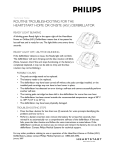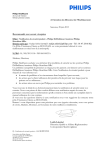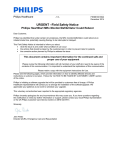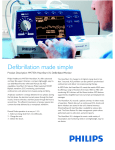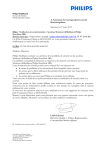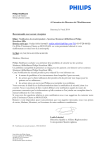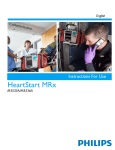Download URGENT – Medical Device Correction
Transcript
Philips Healthcare Emergency Care Solutions -1/4- FSN86100113A 2012 June URGENT Voluntary Medical Device Correction HeartStart MRx Therapy Cable Connection Wear May Lead to a Malfunction in Detection of Defibrillation Pads/Paddles Therapy Cables Dear Customer, This letter is to inform you that Philips has identified an issue in the HeartStart MRx monitor/defibrillator. For those customers who had previously purchased HeartStart MRx monitor/defibrillators prior to July 2009 this letter may also serve as a re-notification that provides additional information regarding this issue. Under certain conditions, use of the HeartStart MRx Defibrillator Monitor with the pads/paddles therapy cable could pose a risk for patients and/or caregivers. This Field Safety Notice is intended to inform you about: x x x What the problem is and under what circumstances it can occur Actions you must take Actions taken by Philips to address the problem This document contains important information for the continued safe and proper use of your equipment Please review the following information with all members of your staff who need to be aware of the contents of this communication. It is important to understand the implications of this communication. When used in external transport and Emergency Medical Service (EMS) environments the mechanical/electrical connection (connector pins and/or port pins) between the pads/paddles therapy cable (including pads CPR therapy cable and external paddles cable) and the MRx therapy connection port may experience high levels of stress causing accelerated wear. Without routine periodic inspections and preventive action by users, accelerated wear of the connection could ultimately prevent the device from sensing that the pads/paddles therapy cable is connected. This wear also may cause the MRx to misidentify the pads therapy cable, external paddles, or internal paddles when they are connected to the therapy port which could result in a delay of therapy, incorrect energy delivered, spontaneous/unintended therapy energy discharge, shock to caregiver when delivering therapy, and/or interrupted pacing with lost capture and inability to regain cardiac recapture. 1 Philips Healthcare Emergency Care Solutions -2/4- FSN86100113A 2012 June Please see the attached Field Safety Notice, which describes how to identify affected devices and provides instructions for actions to be taken. Please follow the “ACTION TO BE TAKEN BY CUSTOMER/USER” section of the notice. Should you have any questions or concerns about this Device Correction, please contact your local Philips representative <key market add contact info here>. This notice has been reported to the appropriate Regulatory Agencies. Philips apologizes for any inconveniences caused by this problem. Ensuring that you have the highest quality medical devices, accessories and supporting documentation is our top priority. Your satisfaction with Philips products is very important to us. Sincerely, General Manager Emergency Care Solutions Attachments 2 Philips Healthcare Emergency Care Solutions -3/4- FSN86100113A 2012 June Field Safety Notice AFFECTED PRODUCTS Product: Philips HeartStart MRx monitor/defibrillators, models M3535A and M3536A, M3536J, M3536M, M3536MC, M3536M1, M3536M2, M3536M3, M3536M4, M3536M5, M3536M6. Units Affected: All Philips HeartStart MRx monitor/defibrillators manufactured prior to June 2012 and used in external transport and Emergency Medical Service (EMS) environments, distributed worldwide. Manufactured by: Philips Healthcare, 3000 Minuteman Road, Andover, MA, 01810. PROBLEM DESCRIPTION When HeartStart MRx Defibrillator Monitors are used in external transport and EMS environments the mechanical/electrical connection between the pads/paddles therapy cable (including pads CPR therapy cable and external paddles cable) and the MRx therapy connection port may experience higher than expected levels of stress causing accelerated wear. Without routine periodic inspections and preventive action by users, wear of the connection could ultimately prevent the device from sensing that the pads/paddles therapy cable is connected. This wear also may cause the MRx to inappropriately identify the pads therapy cable, external paddles, or internal paddles. Pads/paddles therapy cable and therapy connection port wear could pose a risk for patients and/or caregivers. HAZARD INVOLVED If pads/paddles therapy cable and therapy connection port wear were to occur, there is a potential that one or more of the following can occur. A. Delay of therapy B. Incorrect energy delivered C. Spontaneous/unintended therapy energy discharge D. Shock to caregiver when delivering therapy E. Interrupted pacing with lost capture and inability to recapture HOW TO IDENTIFY AFFECTED PRODUCTS The model number and manufactured month/year of your HeartStart MRx monitor/defibrillator can be located on the primary label on the back of the MRx in battery bay B. 3 Philips Healthcare Emergency Care Solutions ACTION TO BE TAKEN BY CUSTOMER / USER -4/4- FSN86100113A 2012 June Carefully read the attached HeartStart MRx Instructions for Use Addendum. Immediately implement ongoing therapy connection inspection on all of your MRx devices to detect wear from higher than expected levels of stress. The HeartStart MRx Instructions for Use Addendum describes how a user can identify wear. If wear is detected, remove affected devices immediately from use and contact Philips to arrange for service. WARNING: The service life of your therapy cables/external paddles is up to three years. To maintain reliable performance and reduce the possibility of failure during patient use, replace them every three years from the time they were initially placed into service or if they fail the inspection criteria in the attached Instructions for Use Addendum. ACTIONS PLANNED BY PHILIPS Philips is voluntarily initiating a corrective action consisting of the following: x This urgent Voluntary Medical Device Correction letter x Distribution of revised Instructions for Use addendum with complete user information regarding ongoing inspections of pads/paddles therapy cable and therapy connector port. x Service support for Therapy Port and Cables requiring replacement. Important Note: Philips is sending each customer site one Voluntary Medical Device Correction letter. The number of HeartStart MRx Instructions for Use Addendums sent with each correction letter is based on the number of MRx units our records shows were delivered to each customer site. Please ensure a copy of the correction letter and the attached revised addendum is co-located with each MRx device. FURTHER INFORMATION AND SUPPORT If you need any further information or support concerning this issue, please contact your local Philips representative <key market add contact info here>. 4 HeartStart MRx Instructions for Use Addendum This document is an addendum to and should be kept with your HeartStart MRx Instructions for Use. Therapy Connection Maintenance and Inspection When Used in Transport NOTE This section of the addendum applies to a HeartStart MRx used in a transport environment. Therapy Connection life depends on the environment in which the device is used. Extra care must be taken when using the HeartStart MRx in external transport and Emergency Medical Service environments as they can place additional stress on the cable connection and increase the chance for wear, impacting its useful life. WARNING To maintain reliable performance and reduce the possibility of failure during patient use: • Perform Therapy Connection inspections weekly to verify pins and port are clean and without residue buildup. If residue is detected, remove the device from service and call your local Philips representative for service. • The service life of your therapy cables/external paddles is up to three years. To maintain reliable performance and reduce the possibility of failure during patient use, replace them every three years from the time they were initially placed into service or if they fail the inspection criteria below. See inspection steps below, also contained in your HeartStart MRx Service Manual. Inspections: • After every patient event where pads or external paddles were used, review the timed events listed in the Event Summary. If you see messages that are inconsistent with what you used (for example Internal Paddles On or Internal Paddles Off when you have pads or external paddles attached or Primary ECG Paddles, External Paddles On or External Paddles Off when you have pads attached), take the cable and device out of service and contact your local Philips Response Center. • During Operational Check, if you see messages inconsistent with what you used, take the device out of service and contact your local Response Center. • Inspect all Therapy Connectors and Therapy Port weekly as part of a routine Operational Check or Weekly Shock Test: 1 Disconnect the Therapy Connector from the Therapy Port on the right side of your HeartStart MRx (Fig. 1). 2 Look inside the green Therapy Connector (Fig. 2). Confirm the connector pins are a clean, gold color, straight and without residue. Confirm the gasket is in place and not torn. 3 Look inside the green Therapy Port on the device (Fig. 3). Confirm the contact holes are clean, uniform in appearance and without residue. 4 If the pins are clean and not bent, the gasket is in place and not torn, and the Therapy Port is clean, reconnect the cable and return to service. If the condition of the Therapy Port and/or the Therapy Connectors are not as described in Steps 2 and 3, take the device out of service and contact your local Response Center. Fig. 1 - Therapy Connections Therapy Port Therapy Connector Fig. 2 - Looking inside the Therapy Connector Gasket Connector Pins Fig. 3 - Looking inside the Therapy Port Clean contact holes During Patient Care As stated in the HeartStart MRx Instructions for Use, confirm the selected energy and lead are displayed before delivering a shock. If the display is incorrect, ensure your cables are properly connected to the Therapy Port. Disconnecting and reconnecting the cable may resolve the issue. After patient care is complete: if you saw an incorrect display, perform the inspections listed above. If indicated, take the cable and device out of service and contact your local Philips Response Center. Stabilizing Lid - Quick Connect/Release Your HeartStart MRx may be equipped with a Therapy Cable Stabilizing Collar and Lid. To connect the Stabilizing Lid to the HeartStart MRx: 1 Plug the Therapy Cable into the green connector port (Figure 4 - Step 1) 2 Place the Stabilizing Lid over the Therapy Cable. Slide the lid hooks into the holes on the lower lip of the base. Then push the lid into place. (Figure 4 - Step 2) 3 Press the lid latch in and turn to the right to lock into place (Figure 4 - Step 3) Figure 4 Stabilizer Lid 1 2 3 Stabilizing Lid Stabilizing Collar 4 To remove the cover, lift up on the lid latch and turn to the left. After the screw disengages, lift the lid out of place. You can also use a flat-head screwdriver to engage and disengage the cover. CAUTION • Some older Philips carry cases are not compatible with the Stabilizing Collar. Once you have installed the Stabilizing Collar, confirm that your carry case does not interfere with the use of the Stabilizing Collar base unit. If it does, please contact your local Philips Response Center. • If the Stabilizing Lid does not fit properly over the Therapy Cable, please contact your local Philips Response Center. Specification updates The following specification changes are updates to the HeartStart MRx Instructions for Use labeled for use with software Version F: Weight: 13.9 lbs. or less, including pads, pads cable, battery and a full roll of paper. Incremental weight of external standard paddles and paddles tray is less than 2.5 lbs. Additional battery weighs less than 1.8 Lbs. Chemical Content: REACH requires Philips Healthcare to provide chemical content information for Substances of Very High Concern (SVHC) if they are present above 0.1% of the product weight. Components of/within electric and electronic equipment may contain phthalates above the threshold (e.g. bis(2-ethyl (hexyl) phthalate), CAS nr.: 117-81-7). The REACH SVHC list is updated on a regular basis. Therefore please refer to the following Philips REACH website for the most up-to-date information on products containing SVHC above the threshold: http://www.philips.com/about/sustainability/reach.page. PUBLISH









